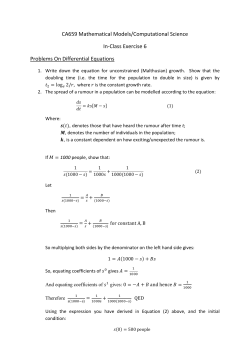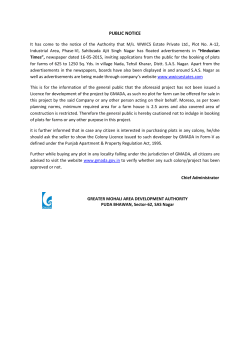
3.1 exponential growth worksheet
3.1 Exponential Growth – Worksheet MCR3U Jensen 1) An insect colony, with an initial population of 20, quadruples every day. a) Complete the table. b) Is the relationship between the insect population and the number of days exponential? Explain how you can tell. 2) Suppose that there is a rumour going around your school that next year all weekends will be extended to three days. Initially, on day 0, five students know the rumour. Suppose that each person who knows the rumour tells two more students the day after they hear about it. Also assume that no-‐one hears the rumour more than once. How many people will learn about the rumour… i) on day 1 ii) on day 2 3) A bacteria colony has an initial population of 200. The population triples every week. a) Write an equation to relate population, 𝑝, to time, 𝑡, in weeks. b) Determine the approximate population after 10 days. c) Determine the approximate population after 12 weeks. 4) An investment of $4000 earns interest, which causes it to increase by 6% per year. a) Write an equation for the amount, A, in dollars, that the investment is worth as a function of time, n, in years. b) Determine the amount that the investment is worth after i) 2 years ii) 10 years iii) 20 years c) What is the value and meaning of the function at n = 0? d) Graph the relation for n = 0 to n = 20. e) How long does it take for the investment to be worth $20 000? 5) A colony of bacteria starts with 400 cells and doubles in number every two days. A second colony of bacteria starts with 200 cells and quadruples in number every day. Write an equation to model the population of each colony, A, to time, t, in days. BONUS: Bacteria A has an initial population of 500 and doubles every day, while bacteria B has an initial population of 50 and triples daily. After how long will the population of B overtake the population of A? What will their populations be at this point? (Hint: product rule for logarithms) Answers 1) a) b) the values in each difference column increase by a factor of 4. 2) i) 10 ii) 20 3) a) 𝑝 = 200 3 ! b) 961 c) 106 288 200 4) a) A = 4000(1.06)n b) i) $4494.40 ii) $7163.39 iii) $12 828.54 c) At n = 0, A = $4000, which is the initial value of the investment. d) e) approximately 27.6 years ! 5) 𝐴 = 400 2 ! and 𝐴 = 200 4 !
© Copyright 2025










